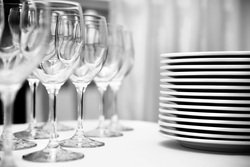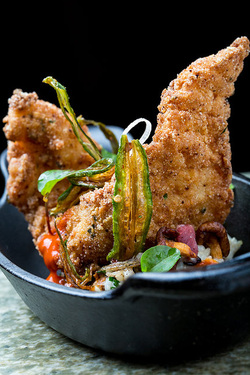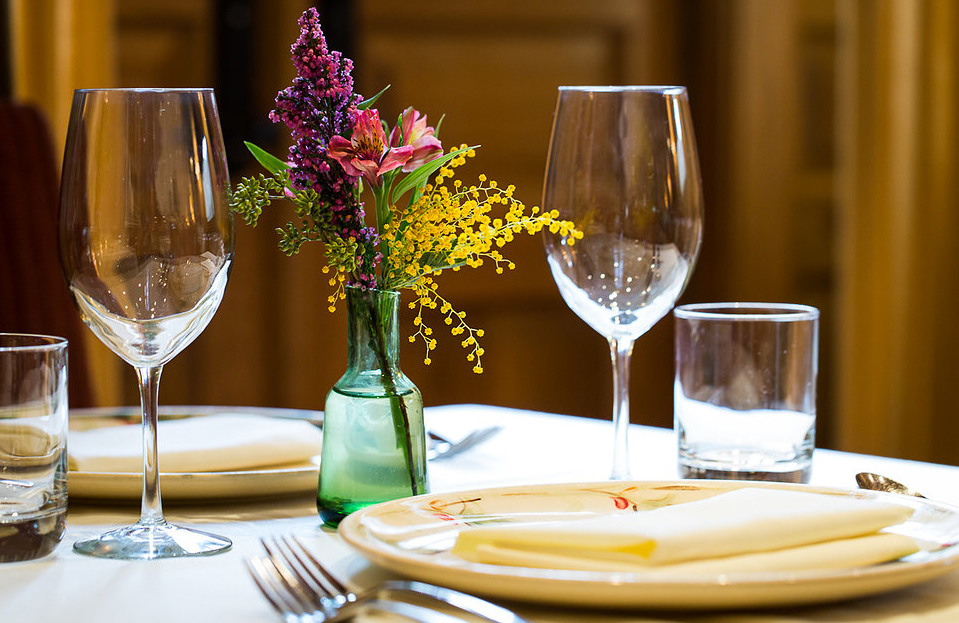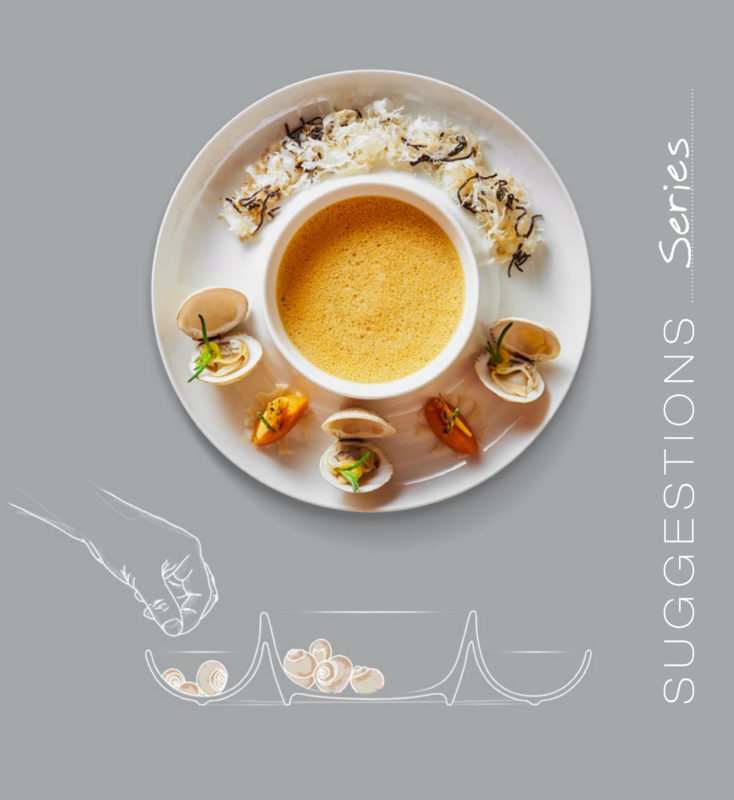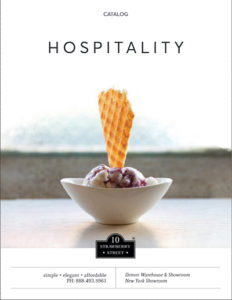Michael Warner Dining is much more than the food. And the dinnerware is much more than simply framing the food. All of us in the hospitality tableware trade, and lovers of fine dining, have endured decades of painfully boring white dinnerware on white napery, in nondescript dining venues, often accented with white décor. We’ve been drowning in a sea of white. But we didn’t say anything, did we? We didn’t respond as professionals “in the business” or as diners. We simply bought into the prevailing belief that it takes an all-white backdrop to truly display a chef’s culinary creation. This whole notion of “framing the food” has become the primary objective of the tabletop even though we knew intuitively there were many more elements in the dining experience. I don’t know where this idea originated first. Did it come from our chefs or from the trade who supplied them? Either way, this belief launched a decade of insisting the sole function of dinnerware was to be the canvas on which chefs daubed and painted on their multi-colored cuisine.
Digging a little deeper, I have to wonder whether it was the culinary schools who led this charge or was it us, the marketers of hospitality dinnerware, humming the mantra of more sales volume at any price. Even at the expense of the dining experience. I tend to believe it was the latter. Either way, an entire market segment jumped on the band-wagon. It didn’t take long to be stuck in this styling rut. Factories shifted their manufacturing efforts to make it, a whole generation of sales and marketing specialists were trained to sell it, and it became the standard among chefs and dining establishments. The white color of the dinnerware wasn’t the whole story either.
Compounding this focus on white, a limited range of products followed. The product selection became was limited to a 12″ dinner plate (most likely with a narrow rim), a cup and a saucer, a bread and butter plate, and a soup or pasta bowl. Our tables were set with more of the same. Nothing was changing in our total dining experience. It became so entrenched that if a manufacturer really wanted to get a little experimental and “edgy” they would most likely limit this creative effort to a little relief on the rim.
Wow! That’s cutting-edge and exciting. (sarcasm duly noted) I suppose a case for “so what” can be made. Was all of this really hurting the dining experience? If nothing else, the food would most likely meet the diner’s expectations. But they had no other frame of reference. The cuisine was really the only point of distinction with possibly the exception of a little creativity in dining venue ambience thrown in for good measure. This is precisely my point. The agonizing consistency in product shape and color did hurt something. In my opinion, it placed an enormous burden on our chefs to create and display on a very narrow stage. Everyone eventually loses something in that dining experience.
Those of us engaged on the supply side of the business were happy with the direction tabletop was going. Creativity and product development is risky and imperfect. Not many factories or brands really wanted to do much of it. Launching a new shape with in-house manufacturing resources is very expensive. Not many brands wanted to take on the inventory risks of outsourcing manufacturing either. And selling dinnerware in general, as brands or dealers, is not for the weak-of-heart. It takes a specific skill set and it’s highly competitive. Whether our chefs were interested in reaching out to the edges of dinnerware tabletop possibilities is largely irrelevant. There generally wasn’t a marketing condition that would have allowed them even if they wanted to. But in the words of Bob Dylan; “The times they are a changing.” Thankfully for us, the diners, fine dining has always been an evolving business and dining experience. ©Eric Kleinberg Photography Fortunately, for this diner and practitioner in the hospitality tableware industry, our fine dining experience is becoming an EXPERIENCE in capital letters. Our chefs today are coming to us from many different “schools” of culinary arts. Many more young chefs are setting up their own kitchens following apprenticeships ranging from high volume to fine dining operations. These marvelous young chefs are serving up cuisine on entirely different tabletop concepts that extend and enhance our total dining experience. A table set with classic “white china” is giving way to a 10″ coupe plate, colorful geometric side pieces, a brass butter dish from the Middle East and a brick. I don’t know what purpose the brick serves but it seems to belong there. Gone is the white napery replaced with weathered wood tabletops. Those utilitarian stainless and plastic water pitchers have been replaced by sanitized glass bottles with a cork simply left on the table for self-serve. Stainless flatware is trending to European sizes and tabletop accessories have no limit to creativity. And I’m seeing more and more organic shapes and colors exhibited at leading hospitality trade shows in Europe, Asia, and the United States.
So, to those of you who have said:
“plain white dinnerware will never go out of style,”… better buckle up!
After year years of participating in an industry intent on maintaining the tabletop status quo, a handful of brave brands have taken on the enormous risks in creativity and development to introduce a whole new range of shapes and colors. These brands (and you know who they are) have now set the hospitality dinnerware course in fine dining for the foreseeable future. If you are in the dinnerware business and you haven’t added at least a minimum of these colors and shapes to your marketing arsenal, you’re going to miss the trend. As we all know, once placed, the tabletop selection will remain for a solid five to seven years. Do you really want to be on the fringe of the tabletop segment that long?
On an even more exciting note, a handful of truly creative chefs in every major dining market, who really understand the fusing of venue, food, and the table are responding. These chefs are delivering a remarkable dining experience that challenges to their customers all of their customer’s senses. This is what fine dining today is all about. Chef Art Smith’s Table Fifty-Two restaurant is the home of Southern hospitality in Chicago. ©Eric Kleinberg Photography There is one particular chef and dining venue in the Chicago dining market who challenged the prevailing belief that fine dining could not stray far from the traditional white tabletop design very early and very successfully. I’m speaking of Chef Art Smith and his restaurant Table 52. This restaurant is one of my local favorites, on many levels – architecture, cuisine, remarkable wait staff, and yes, especially the tabletop. While our industry is still on the cusp of an emerging trend toward color on the tabletop, Chef Smith was truly a pioneer and a visionary. He did what we all in the tableware trade profess to do but seldom deliver – a total fusing of architectural design, food, and tabletop. While we were out there in the marketplace extolling the virtues of yet another white dinnerware with a slight change in shape, Chef Smith was going an entirely different direction. Rather than accepting the basic white status quo he turned instead to dark floral prints on neutral organic glazes, set on dark natural wood, complimented by the period décor of a southern home. His tabletop reinforces Table 52’s marvelous southern regional cuisine with a Kentucky twist. I encourage you to visit Table 52 during Restaurant Week which coincides with the National Restaurant Show in Chicago in May. Sample the marvelous cuisine and enjoy a totally fused dining experience.
The punch-line to all of this, and the point which particularly concerns me, is that we in the hospitality tableware business couldn’t or wouldn’t respond to the early signal of trends to come. In fact, we could have set those trends in motion years ago. Instead we waited for a small number of brands with a vision and brave restaurateurs like Chef Smith to lead the way. How many other tableware brands and Chefs like Art Smith are there out there, going in new directions, delivering a total dining experience to their guests, while we in the trade fail to listen? I’m sure history will repeat itself.
Michael Warner bio:
Following stints in global supply management with McDonald’s Corporation, Edward Don & Company, and as an independent consultant; Michael Warner has spent 22 years as Managing Director of Global Supply Chain Management with Allied Buying Corporation, a leading foodservice equipment and supply buying group. In this capacity Mike developed global supply management strategies in support of the tableware channel.


